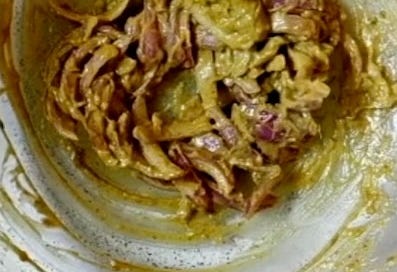When first hearing the word khadi or maybe khaki, I got confused. I wasn’t sure what word was being spoken. I had heard khaki before, and what was being said didn’t really sound like that. In Hindi and Urdu, both words khadi or khaki typically refer to handspun cloth, famously promoted by Mahatma Gandhi during India’s independence movement. I actually knew that about khaki, but not khadi.
I don't know Hindi nor Urdu, at all obviously, but I was pretty sure that khaki was not something I wanted to eat. So I checked, because I know I really don’t know anything about either of those languages, both of which are used to convey cultural practices I’ve never heard of. Khaki and khadi are both definitely cloth, not food, as far as anyone was willing to claim they were certain of being the case.
Kadhi (कढ़ी / کڑھی) is a North Indian dish made by cooking yogurt and gram flour (besan) together with spices like turmeric, cumin, mustard seeds, and chilies. The mixture is simmered gently until it thickens slightly and develops a deep, slightly sour flavor.
Traditionally eaten with steamed rice or soft roti, It’s comfort food. A lot of that comfort derives from the place it is or was originally eaten.
Pakora—fried fritters made by mixing vegetables into a seasoned gram flour batter and fried - is sometimes added to kadhi. Gram flour is made from chickpeas. They are added into the kadhi near the end of cooking. They soak gently in the curry, absorbing its tangy warmth while remaining tender. This transforms the simple yogurt curry into kadhi pakora.
Chaas is buttermilk. When butter is made from cream, the leftover liquid is lush buttermilk—light, thin, and slightly sour. In most Indian kitchens, chaas (छास / چھاس) - okay we’re discussing Indian food so Gujarati or Punjabi might have a different pronunciation, or even word for it - is typically made by diluting thick yogurt (dahi) with water and whisking it, sometimes seasoning it with salt or cumin. It is this chaas, or a close homemade version of it, that forms the base of many kadhi recipes.
Cooks replace chaas with a quick blend of thick yogurt, water, and gram flour - yes my vegan friends you can replace the dairy yogurt with a plant based one - to perform the same role. It thickens and flavors the kadhi without the need for real buttermilk. It's how many households actually prepare their kadhi on a day-to-day basis.
So. Kadhi is a yogurt, water and gram flour curry. Pakora are vegetable fritters. Chaas is buttermilk, but is quite often substituted by thinned out yogurt. Diluted yogurt is often used to create curry bases. Khadi is cloth, not food. Khaki is something you wear. If you’re into that.
Recognizing the subtle differences in pronunciation and context is essential to understanding the layers behind these words and recipes.
There is so much history and tradition that comes with this simple dish that it should be listed as an ingredient.
Whether prepared with chaas or whisked yogurt, served plain or with onion pakora, kadhi tastes like home. What could taste better than a place that someone choses to call home, or desperately yearns to be at?


